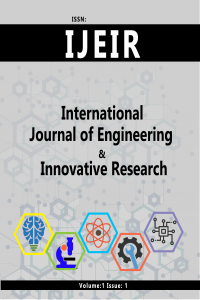Microbial Fuel Cell Potential in Augmenting Nigerias’ Energy Mix
Microbial Fuel Cell Potential in Augmenting Nigerias’ Energy Mix
Microbial Fuel Cell, Mediatorless, Organic Matter, Power, Voltage Current, LED bulbs, Energy Mix,
___
- [1] Claudine Ellyin (2012). “Small Scale Waste-To-Energy Technologies”. International Journal of Engineering Research and Science. Vol. 7, No. 8.
- [2] Diji, C.J. (2013). “Electricity Production from Biomass in Nigeria: Options, Prospects and Challenges”. International Journal of Engineering and Applied Sciences. ISSN2305-8269, Vol. 3, No. 4, June.
- [3] Kun Guo, Daniel J. Hassettb and Tingyue Guc (2012). “Microbial Fuel Cells: Electricity Generation from Organic Wastes by Microbes”. ISBN: 978-1845939564, pp 164-189. CAB International, Oxon. United Kingdom.
- [4] Ismail Bozkurt (2010). “Energy Resources and Their Effect on Environment”. WSEAS Transaction on Environment and Development. Issue 5, Vol. 6. ISSN: 1790.5079.
- [5] Mokhtarian N., Rahimnejad M., Najafpour G.D., Wan Ramli Wan Daud, Ghoreyshi A.A.,(2012). “Effect of Different Substrate on Performance of Microbial Fuel Cell”. African Journal of Biotechnology Vol. 11(14), pp. 3363-3369, 16 February.
- [6] Matteo Daghio, Isabella Gandolfi, Giuseppina Bestetti, Andrea Franzetti, Edoardo Guerrini and Pierangela Cristiani (2015). “Anodic and Cathodic Microbial Communities In Single Chamber Microbial Fuel Cells”. New Biotechnology Volume 32, Number 1.
- [7] Osueke C.O. and Ezugwu C.A.K. (2011). “Study of Nigeria Energy Resource and Its Consumption”. International Journal of Scientific and Engineering Research, Vol. 2, Issue 12. ISSN: 2229-5518.
- [8] Dincer I. and Zamfirescu C. (2011). “Sustainable Energy Systems and Applications”. Springer Science and Business Media. DOI: 10.1007/978-0-387-95861-3.2.
- [9] Ajayi, O.O., and Ajanaku K.O (2010). “Nigeria’s Energy Challenge and Power Development: The Way Forward”. Energy & Environment · Vol. 20, No. 3.
- [10] Osueke C.O. and Ezugwu C.A.K. (2011). “Study of Nigeria Energy Resource and Its Consumption”. International Journal of Scientific and Engineering Research, Vol. 2, Issue 12. ISSN: 2229-5518.
- [11] You, J. (2016). “Waste and Wastewater Cleanup Using Microbial Fuel Cells”. University of the West of England. Available from: http://eprints.uwe.ac.uk/26953.
- [12] Sridhar M.K.C., and Hammed T.B. (2014). “Turning Waste to Wealth in Nigeria: An Overview”. Journal of Human Ecology, 46(2): 195-203.
- [13] Simonyan K.J., and Fasina O., (2013). “Biomass Resources and Bioenergy Potentials In Nigeria”. African Journal of Agricultural Research. Vol. 8(40), pp.4975-4989. DOI:10.5897/AJAR2013.6726.
- [14] Samuel Mark Maton, Davou Daniel Dabi, Juliet Dingsten Dodo, Ruth Asheazi Nesla (2009). “Environmental Hazards of Continued Solid Waste Generation and Poor Disposal in Municipal Areas in Nigeria”. Journal of Geography , Environment and Earth Science International.
- [15] International Renewable Energy Agency (2012). Renewable energy technologies: Cost Analysis Series, Volume1: Power Sector, Issue 3/5 Hydropower. 1 (3).
- [16] Igbinomwanhia D.I., Obano A.I., Olisa Y.P., Akhator P.E., (2016). “Evaluation of Waste To Energy Potential of Domestic Solid Waste In Benin Metropolis”. Journal of Applied Science and Environmental Management. Vol. 20 (4) 1089-1092.
- [17] Dincer I. and Zamfirescu C. (2011). “Sustainable Energy Systems and Applications”. Springer Science and Business Media. DOI: 10.1007/978-0-387-95861-3.2
- Yayın Aralığı: Yılda 3 Sayı
- Başlangıç: 2018
- Yayıncı: Ahmet Ali SÜZEN
Design and Development of a Grass Grinding Machine
Godspower OJARİAFE, Ketra ABUMERE
FUZZY CONTROL OF CIRCUIT BREAKERS IN POWER TRANSFORMER CENTERS
MUSHROOM SPECIES DETECTION USING IMAGE PROCESSING TECHNIQUES
Yasemin Rukiye ERKAN, Humar KAHRAMANLI ÖRNEK
ESTIMATION OF DEPRESSION DISEASE BY NEURAL FUZZY INFERENCE METHODD
Zekeriya AKÇAY, Remzi GÜRFİDAN
Microbial Fuel Cell Potential in Augmenting Nigerias’ Energy Mix
